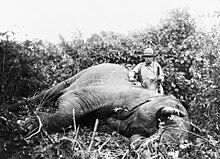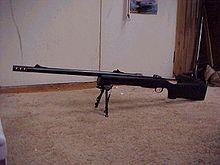Elephant gun
This article includes a list of generalreferences,butit lacks sufficient correspondinginline citations.(September 2014) |
| Elephant gun | |
|---|---|
| Type |
|
| Service history | |
| Wars | |

Anelephant gunis a largecalibergun,rifledor smoothbore, originally developed for use bybig-game huntersforelephantand otherlarge game.Elephant guns wereblack powdermuzzle-loadersat first, then black powderexpress rifles,then later usedsmokeless powdercartridges.
Early use
[edit]As Europeans made inroads into Africa in the early 19th century, guns were developed to handle the very large game encountered. This was for self-protection, food gathering, and sport. The first guns were the simple muzzle-loading shotgun designs already used for birds and loaded with solid balls of lead for use on large game. Due to their ineffectiveness on the largest game (up to 35 shots being recorded by some writers for a single elephant), they soon developed into largercaliberblack powdersmoothbores.The caliber was still measured in bore orgauge—10, 8, 6,4 bore,and2 bore—or the guns were named by number of projectiles per pound. The projectiles were lead round balls or short conical slugs, sometimes hardened withantimony.[2]
These very large and very heavy firearms were the first to be known as the elephant guns of the black powder era (1850—1900), though their use also included all thick-skinned dangerous game such as rhinoceros, hippopotamus and cape buffalo. Due to the velocity limitations of black powder and lead—usually around 460 metres per second (1,500 ft/s)—the only way to increase penetration was to make a larger gun. The largest-bore guns in common use (and bore rifles with the advent of breech loading and rifling in the late 19th century) included the-4 bore, using a 130-gram (2,000 gr) slug at up to 430 m/s (1,400 ft/s). Despite their enormous power, the short low-velocity slugs still suffered the penetration issues which plagued guns of this era, particularly for the toughest shot of all: defeating the bone mass for a frontal brain shot on an elephant. Thus, dangerous game hunting in the 19th century was as much a test of the gun-bearer's ability to relay guns to the hunter, and of horsemanship to evade charges long enough to reload.[2]
Following the bore guns were the brass case "express" rounds, which incorporated black powder with modern ballistics by making relatively smaller projectiles go faster. The dangerous game projectiles were often hardened lead alloy. The.577 Black Powder Expresswas the go-to dangerous game caliber from the 1870s through 1900. It spawned the.577 Express around 1890, which used smokelesscorditeinstead of black powder, and then the.577 Nitro Expressin 1900, which used modern metal jacketed and solid bullets pushed by more modernsmokeless powders.
It was not until the parallel developments of jacketed projectiles, closely followed by smokeless powders in the late 19th century, that dangerous game could be taken with near 100% certainty.[3]
Nitro Express rifles
[edit]
TheNitro Expressline (c.1895), so named because the composition of the early smokeless powders such asPoudre B,ballistiteand cordite, were the first of the new order of elephant guns. With smaller metal-jacketed projectiles ranging from 10.2 to 15.7 mm (.400 to.620 in) caliber and velocities around 610 m/s (2,000 ft/s) they possessed vastly improved trajectory and penetration over their black powder forebears. Within a few years the mighty bore guns of the previous era largely disappeared from the gamefields. The safari heyday of the early 20th century "nitro era" records much literature on such calibers as the.577 Nitro Express,.375 H&H Magnum,.416 Rigby,.404 Jeffery,.505 Gibbs,.450 Nitro Express,and.470 Nitro Express.These rifles came out in single shot,bolt action,and double rifle configurations and continued to be used until ivory hunting died off in the mid-20th century. Thereafter, they largely switched roles to tools for game wardens and as back-up firearms for professional hunters guiding international hunters.[4]
The American gun market produced several famous dangerous game cartridges around this time, such as the.458 Winchester Magnum,.378 Weatherby Magnumand.460 Weatherby Magnumand many of these were "wildcatted"(to modify an existing case and rifle to fire a different caliber bullet). The rest of the old Nitro express calibers had faded into obscurity until a resurgence in safari hunting came about in the 1970s and 1980s. This prompted a new boom in elephant gun development and calibers such as the.416 Weatherby Magnumand.416 Remington Magnumarrived in factory offerings. The late 1980s and 1990s produced the.700 Nitro Expressand the new brass manufacturers allowed even more powerful elephant guns such as the.585 Nyatiby Ross Seyfried,.577 Tyrannosaurby Colonel Art Alphin and.585 Gehringer by Karl Gehringer to be made by wildcatters. The.600 Overkillmade by Rob Garnick represents the greatest power available from a standard hunting action. Other wildcats based on the heavymachine gun.50 BMGand similaranti-materielrounds have been devised which are much more powerful, though they are not generally considered useful hunting arms as their weight usually exceeds 11 kg (25 lb).[5]
Use in wartime
[edit]DuringWorld War I,both theBritishandGerman armiesused elephant guns obtained from their African colonies on theWestern Front.The British used elephant guns as a means of countering the German tactic of having theirsnipersadvance towards enemy lines under the cover of a large, 6–10 millimeter (0.24–0.4 inch) thick steel plate. Though normal small arms were ineffective against the plate, elephant guns of the era had enough force to punch through. Additionally, to penetrate steel plateloopholes,large caliber firearms, such as elephant guns, were deployed to eliminate snipers.[6]
InWorld War II,Prince Amedeo, Duke of Aostagave his personal collection of elephant rifles toRoyal Italian Armytroops under his command during theEast African campaign.They were used to target Britisharmored cars,as Italian forces suffered from a lack ofanti-tank gunsduring the campaign. TheLahti L-39,a Finnish-made20 mm caliberanti-tank gun, was nicknamed the "elephant gun" byFinnish Armytroops during theContinuation Warbecause of its stopping power, as was the British-madeBoys anti-tank rifle.[citation needed]
See also
[edit]References
[edit]- ^Metesh, T. Logan (October 12, 2022)."ROOSEVELT'S LEGENDARY DOUBLE RIFLE, THE 'BIG STICK,' UP CLOSE".Retrieved30 August2023.
- ^abFadala, Sam (17 November 2006)."They were after ivory".The Complete Blackpowder Handbook.Iola, Wisconsin: Gun Digest Books. pp. 404–412.ISBN0-89689-390-1.[permanent dead link]
- ^Whitney, Caspar;Britt, Albert (1903).Outing: Sport, Adventure, Travel, Fiction.W. B. Holland. pp. 116–117.
- ^Tabor, Thomas C. (2013).Shooter's Bible Guide to the Hunting Rifle and Its Ammunition.Skyhorse Publishing Company, Incorporated. p. 65.ISBN978-1-62873-540-6.
- ^Zwoll, Wayne Van (2011).Shooter's Bible Guide to Rifle Ballistics.Skyhorse Publishing Inc. p. 242.ISBN978-1-62087-285-7.
- ^Great War Sniper School
Further reading
[edit]* Boddington, Craig(1990),Safari Rifles,Long Beach, California:Safari Press.ISBN 0-940143-49-6
